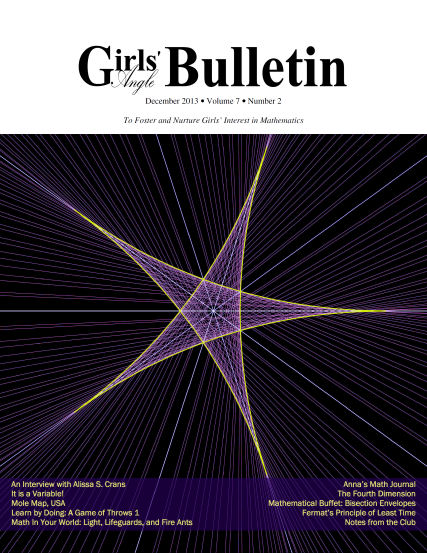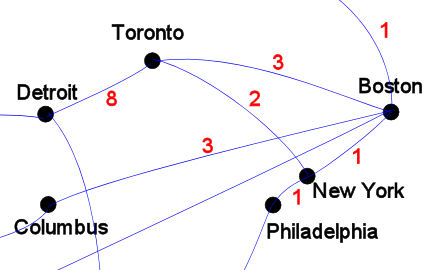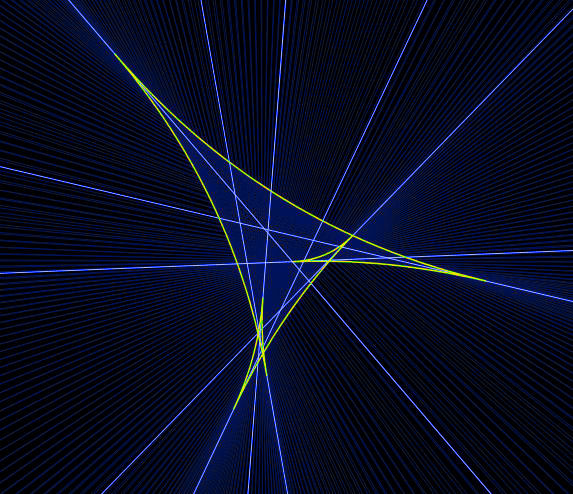 The electronic version of the latest issue of the Girls’ Angle Bulletin is now available on our website.
The electronic version of the latest issue of the Girls’ Angle Bulletin is now available on our website.
In Bisection Envelopes, a paper to appear in the journal Involve, Noah Fechtor-Pradines proves many interesting properties of the envelope of the set of lines that split a planar shape into two halves of equal area. The cover shows the bisection envelope of the regular pentagon and in Math Buffet, you can see more images of bisection envelopes that illustrate just a few of the properties Noah discovered. Try to sketch the bisection envelope of a semicircle, then check out the one in the Bulletin.
In this issue’s interview, meet Associate Professor of Mathematics at Loyola Marymount University, Alissa Crans. She gives a lot of great advice and also tells us how she got into math. She explains some of her goals as the Associate Director of Diversity and Education at the Mathematical Sciences Research Institute and her work at Pathways.
 This fall, Akamai mathematician Kate Jenkins visited the Girls’ Angle club and explained Dijkstra’s algorithm for finding optimal paths in graphs. You can try your hand at applying Dijkstra’s’ algorithm in Mole Map, USA. She also described what it is like to work at Akamai, which creates products that make the internet run more efficiently.
This fall, Akamai mathematician Kate Jenkins visited the Girls’ Angle club and explained Dijkstra’s algorithm for finding optimal paths in graphs. You can try your hand at applying Dijkstra’s’ algorithm in Mole Map, USA. She also described what it is like to work at Akamai, which creates products that make the internet run more efficiently.
 Robert Donley, a.k.a. Math Doctor Bob, launches our new column, Learn by Doing, with a problem concerning dice. In Learn by Doing, we are going to present mathematics by posing problems. We hope you make a point of learning math actively, with pencil and paper in hand. If you particularly enjoy learning by solving problems, check out Combinatorial Problems and Exercises, by László Lovász.
Robert Donley, a.k.a. Math Doctor Bob, launches our new column, Learn by Doing, with a problem concerning dice. In Learn by Doing, we are going to present mathematics by posing problems. We hope you make a point of learning math actively, with pencil and paper in hand. If you particularly enjoy learning by solving problems, check out Combinatorial Problems and Exercises, by László Lovász.
Two hurdles to overcome in mathematics are gaining facility with variables and thinking in higher dimensions. For variables, Tim Chow, a mathematician who works at the Center for Communications Research, brings us It is a Variable! And for the fourth and higher dimensions, we offer The Fourth Dimension. It’s truly remarkable that we are able to think about objects that cannot be realized in the physical world but only exist in our minds. In fact, we define mathematical objects with such precision and detail, that, in some sense, they can even seem more real than physical objects!
In our regular columns, Anna continues looking at products of consecutive integers with respect to whether or not they can be perfect squares and Lightning Factorial discusses Fermat’s Principle of Least Time in Math In Your World.
We hope you enjoy it!
Finally, a reminder: when you subscribe to the Girls’ Angle Bulletin, you’re not just getting a subscription to a magazine. You are also gaining access to the Girls’ Angle mentors. We urge all subscribers and members to write us with your math questions or anything else in the Bulletin or having to do with mathematics in general. We will respond. We want you to get active and do mathematics. Parts of the Bulletin are written to induce you to wonder and respond with more questions. Don’t let those questions fade away and become forgotten. Send them to us!
We continue to encourage people to subscribe to our print version, so we have removed some content from the electronic version. Subscriptions are a great way to support Girls’ Angle while getting something concrete back in return. We hope you subscribe!

